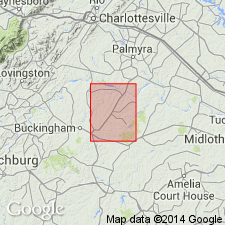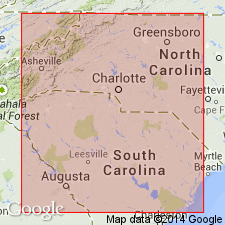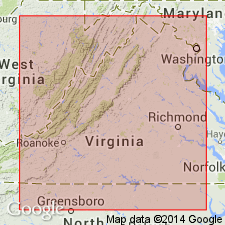
- Usage in publication:
-
- Hatcher Complex
- Modifications:
-
- Named
- Dominant lithology:
-
- Gneiss
- Diorite
- AAPG geologic province:
-
- Piedmont-Blue Ridge province
Summary:
Hatcher Complex named for Hatcher, Cumberland Co., central VA. Exposed in extreme western Cumberland Co., in vicinity of Hatcher, 9 mi east-northeast of Dillwyn. In Dillwyn quad, consists of gneissic quartz diorite, dioritic hornblende gneiss, and migmatitic combinations of the two; augen gneiss and gneissic equivalents of quartz monzonite and granodiorite occur locally. Best exposures of granitic material in quad are along James River southeast of Bremo Bluff; typical but more restricted exposures occur on north side of Buck and Game Creek, 0.5 mi north of Hatcher. Other typical exposures are 1) along Halfway Creek west and southwest of Hatcher and 2) along VA Hwy 672 in hillslopes on both sides of its crossing of Buck and Game Creek, 1 mi northeast of Hatcher. Granitic rocks in Hatcher Complex were previously called Columbia granite by Taber (1913) and Jonas (1932), but the name conflicts with Columbia Group of Pleistocene age. Smith and others (1964) called these rocks the "granodiorite unit." The "granite near Carysbrook" of Stose and Stose (1948) is now considered part of the Hatcher. In Dillwyn quad, Hatcher rocks merge westward and southwestward without definite limit into metasedimentary rocks older than Arvonia Formation which are present in Whispering Creek anticline; it appears that at least this part of the Hatcher is a product of migmatization and granitization of the metasedimentary rocks. Age is Paleozoic.
Source: GNU records (USGS DDS-6; Reston GNULEX).

- Usage in publication:
-
- Hatcher Complex
- Modifications:
-
- Geochronologic dating
- AAPG geologic province:
-
- Piedmont-Blue Ridge province
Summary:
Rb-Sr whole-rock isochron date of 595+/-80 Ma reported for granite of Hatcher Complex. Age is Cambrian and possibly latest Precambrian based on time scale of Harland and others (1964).
Source: GNU records (USGS DDS-6; Reston GNULEX).

- Usage in publication:
-
- Hatcher complex
- Modifications:
-
- Overview
- AAPG geologic province:
-
- Piedmont-Blue Ridge province
Summary:
Chopawamsic Formation rocks grade into Hatcher complex rocks with increasing metamorphic grade to the southeast. Hatcher complex consists of highly metamorphosed rocks of Chopawamsic Formation based on presence of relict quartzite and amphibolite units traceable into recognizable metabasalt at lower metamorphic grade to the west. Hatcher also contains rocks that probably are infolds of Arvonia Slate and Quantico Slate. Plutons of Ellisville Granodiorite intrude Hatcher complex as well as lower-grade rocks of Chopawamsic Formation.
Source: GNU records (USGS DDS-6; Reston GNULEX).
For more information, please contact Nancy Stamm, Geologic Names Committee Secretary.
Asterisk (*) indicates published by U.S. Geological Survey authors.
"No current usage" (†) implies that a name has been abandoned or has fallen into disuse. Former usage and, if known, replacement name given in parentheses ( ).
Slash (/) indicates name conflicts with nomenclatural guidelines (CSN, 1933; ACSN, 1961, 1970; NACSN, 1983, 2005, 2021). May be explained within brackets ([ ]).

